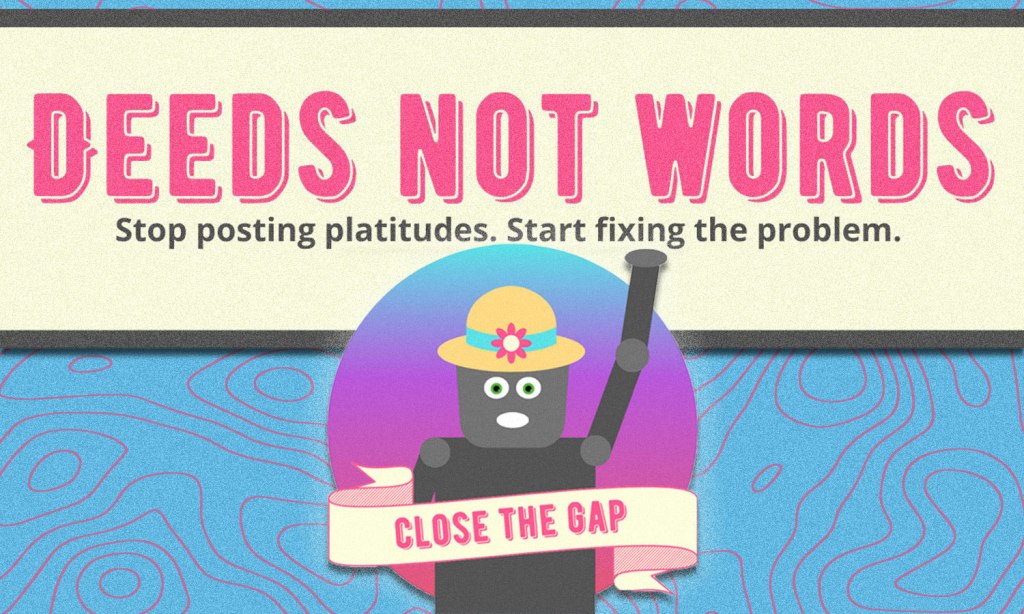You may not be super stoked as a woman to get a cupcake and a pat on the head for International Women’s Day. The corporatisation of March 8 has dragged it a long way from its violent, revolutionary origins and has turned into a safe and controlled space of banal ‘celebration’.
While that’s a shame, if there’s one thing we can all agree on, it’s that large organisations being called out for the hypocrites they are is far more sustaining in this day and age than cupcakes.
And, on International Women’s Day, that delicious schadenfreude is served up in spades thanks to a little thing called the Gender Pay Gap Bot.
In this organisation, women's median hourly pay is 17.4% lower than men's. The pay gap is 9.4 percentage points wider than the previous year. https://t.co/vga1kaSbAY
— Gender Pay Gap Bot (@PayGapApp) March 7, 2023
Last year, the Gender Pay Gap Bot wreaked absolute havoc on employers trying to meekly pay lip service to the idea that they ‘support’ women. Conjured up by British women Francesca Lawson and Ali Fensome, the bot draws on publically available data to automatically retweet the gender pay gaps at organisations that post about International Women’s Day.
“One day a year, companies really go for it and pledge their support for women — and for gender equality, more generally — but don’t do enough the rest of the year,” Lawson told HRDrive.
“It was cobbled together over the space of a weekend. We didn’t know if it was going to work. We didn’t know whether … anyone was going to be interested”.
In this organisation, women's median hourly pay is 28.5% lower than men's. The pay gap is 10.7 percentage points wider than the previous year. https://t.co/lVGdzuDuax
— Gender Pay Gap Bot (@PayGapApp) March 7, 2023
But the people were very interested. Companies tweeted their platitudes, and their actual internal operations were laid bare. The Irish airline Ryanair tweeted that they supported their female staff in 2022 and were slapped with a retweet telling the world that their “women’s median hourly pay is 68.8% lower than men’s.”
It was a PR nightmare. Some companies tried to change their privacy settings to avoid being caught by the bot. Others avoided using the International Women’s Day hashtag. Some simply deleted their tweets.
Lawson has said that she wants the bot to become “a bit of a catalyst” for change by keeping pressure on companies to deliver on the promises of their nice words.
“I always feel this sense of frustration from seeing all these lovely supportive messages from companies, but the needle doesn’t seem to be shifting that much on gender equality more generally. We can see in the gender pay gap data, it’s still a massive problem,” Lawson told The Independent.
In this organisation, women's median hourly pay is 33% lower than men's. The pay gap is 2.4 percentage points wider than the previous year. https://t.co/18eF4AYuqr
— Gender Pay Gap Bot (@PayGapApp) March 7, 2023
Last year, the bot simply tweeted the pay gaps of organisations. This year, Twitter users are able to ask the bot for the gender pay gap data of any company, regardless if they tweet about International Women’s Day or not.
In addition, it also tweets the difference in the gender pay gap of an organisation over the last 12 months. Lawson has said that knowing that some companies make progress on the issue has been “absolutely wonderful.”
In this organisation, women's median hourly pay is 9.5% higher than men's. In the previous year, women's median hourly pay was 54.6% lower than men's. https://t.co/JZQzOuhWnc
— Gender Pay Gap Bot (@PayGapApp) March 8, 2023
“It really is quite useful to see who’s making the process, who’s genuinely putting in the work, and who’s letting it widen,” she said.
The bot works because the UK Government makes companies publish information on their gender pay gap. Unfortunately, that is not the case in Australia, meaning we can’t experience the same shiver of excitement at having our very own companies crash and burn on social media.
However, the Labor Government has recently said that it wants to pursue a policy of transparency whereby companies will be required to publish that information. If they follow through, it means we could soon get our very own gender pay bot in Aus.
So, companies, before this happens and your organisation is publically shamed, maybe you should preempt that possible reality by fixing up your own gender pay gap?
Related: Labor Is Introducing Legislation to Close the Gender Pay Gap
Related: Happy IWD! Women Are Still Earning Significantly Less Than Men in 2023
Read more stories from The Latch and subscribe to our email newsletter.







